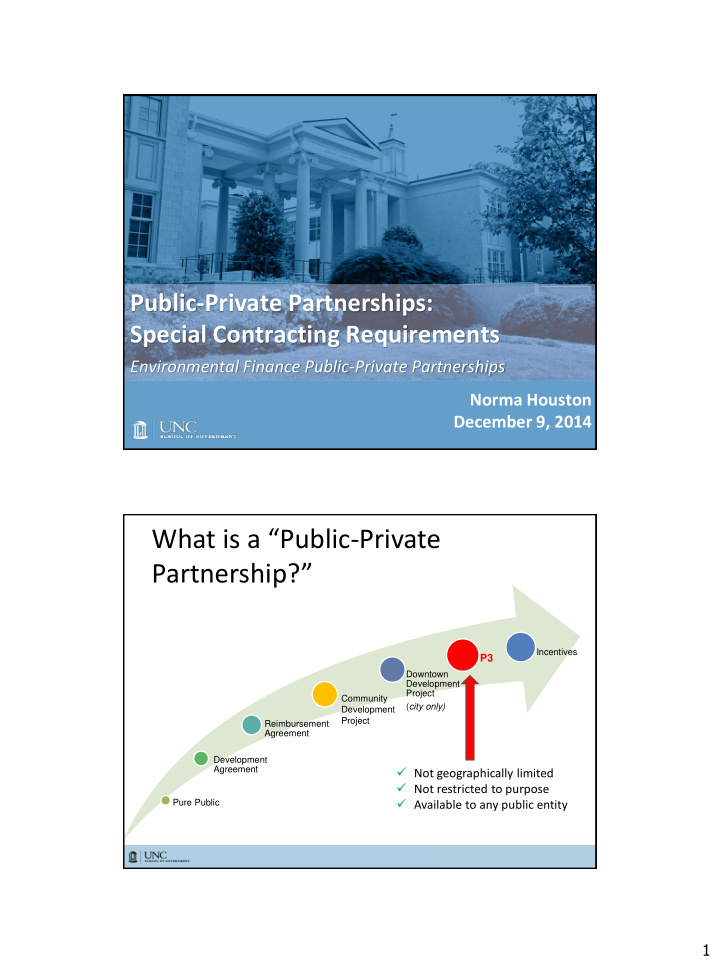



Public-Private Partnerships: Special Contracting Requirements Environmental Finance Public-Private Partnerships Norma Houston December 9, 2014 What is a “Public -Private Partnership?” Incentives P3 Downtown Development Project Community ( city only) Development Project Reimbursement Agreement Development Agreement Not geographically limited Not restricted to purpose Available to any public entity Pure Public 1
The Present . . . Water Street, Downtown Wilmington The Present . . . 2
The Future . . . • 20,000 sq. ft. retail space • 200 residential units • 625 parking space deck • Public use space (such as a park) on parking deck roof Source: UNC School of Government Development Finance Initiative Redevelopment Plan for Water Street Parking Deck (2014) Development Questions Who Is Responsible For: Who Will Receive: Plan development and Revenues approval Building and facilities Permitting property interests (ownership, lease, Construction contracting capital lease, etc.) Operation and maintenance Financing and debt Liability (both during and after construction) 3
NEW CONSTRUCTION DELIVERY METHODS New Construction Methods Authorized in 2013 Legislative Session: 1. Design-Build G.S. 143-128.1A 2. Design-Build Bridging G.S. 143-128.1B 3. Public-Private Partnership (P3) 143.128.1C 4
New Methods Compared Design-Build Public-Private Design-Build Bridging Partnership (P3) • One contract • Two contracts • One contract • DB team • (1) Initial • Private • 100% of designer for developer 35% of design • Shared costs & design + • (2) DB team construction responsibilities for rest of design + construction PUBLIC-PRIVATE PARTNERSHIPS CONTRACTING METHOD 5
Public-Private Partnership (P3) Flexible contracting authority Development agreement for construction, financing, establishes roles and and operation of public- responsibilities of unit and private project developer Developer selected based on LGC must approve capital or qualifications operating lease Developer must finance at least 50% of project cost What is a Public-Private Project? Capital improvement Involves construction of project a public facility or other improvements including: Benefits both a • Paving and grading governmental entity and • Utilities a private developer • Infrastructure Contracted through a • Reconstruction or repair development agreement • May include both public and private facilities 6
Buildings and related facilities (ex: parking) Public-Private Partnership Process Written finding of critical need for the project Step 1 adopted by board at open meeting Step 2 Determine programming needs Step 3 Publish notice of RFQ 7
Public-Private Partnership Process Evaluate proposals; may negotiate with any Step 4 respondents Step 5 Select best qualified developer Negotiate terms and conditions of Step 6 development agreement Public-Private Partnership Process Publish notice of contract terms and Step 7 public hearing 30 days prior to approval Step 8 Conduct public hearing Board approves contract at open meeting Step 9 after public hearing 8
Selecting the Developer Respondents must provide: Evidence of financial stability Experience with similar projects Project team description Availability Projected project timeline Any other information requested in the RFQ Development Agreement MUST Include: MAY Require Developer To: 1. Property interests of unit 1. Construct (or reconstruct) and developer some or all of the project 2. Development 2. Construct additions to the responsibilities of unit and projects developer 3. Perform renovations to 3. Financing obligations of some or all of the project unit and developer 4. Purchase some or all of the (developer responsible for equipment or materials for at least 50% of cost) the project (both initial and 4. HUB good faith efforts subsequent) responsibilities 5. Ensure HUB compliance 9
Hiring Contractors Unit and developer may agree to use the same contractor without competitive bidding – If using the same contractor, development agreement must require construction and purchases to be “at a reasonable price” If using design-build, statutory contracting requirements apply HUB good faith efforts apply to contractor Imagine Your Project . . . 10
Development Questions Who Is Responsible For: Who Will Receive: Plan development and Revenues approval Building and facilities Permitting property interests Construction contracting (ownership, lease, capital lease, etc.) Operation and maintenance Financing and debt Liability (both during and after construction) RESOURCES 11
Coming Soon! Available Spring 2015 through SOG bookstore “Collaborative Construction: Public-Private Partnerships and Downtown Development Projects - A Contract-Drafting Guide for North Carolina Local Governments” Development Finance Initiative Michael Lemanski Christy Raulli DFI Director DFI Interim Asst. Director lemanski@sog.unc.edu raulli@sog.unc.edu 919.962.0942 919.843.7736 12
SOG Coates’ Canons Blog www.canons.sog.unc.edu Thank You! Norma Houston 919.843.8930 nhouston@sog.unc.edu 13
Recommend
More recommend